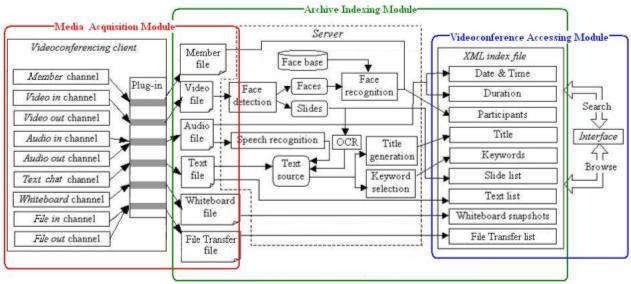
Figure: Overview of PVCAIS
|
Abstract |
Videoconference becomes more and more popular in business activities, personal communications and educations, because of the rapid growth of Internet bandwidth and technical advance of multimedia coding. The participant of a videoconference usually wishes to keep the video archive for the later reference. However, existing videoconferencing clients either do not record or only record the personal conference as ordinary audio and video files, in which the file name is the only place, but not the ideal place, to indicate the subject. Therefore, we can imagine that, in the near future, when a person accumulates many video archives in his/her work, study and daily life, he/she may not be easy to recall the details of a conference without watching it again. Since the visual and aural information is not directly searchable like text, it is also difficult to search out those archives with content of interest by normal searching methods. Therefore, the research of effective indexing personal videoconference archives is of timely importance. However, current efforts on multimedia indexing still focus on digital video libraries or distance learning. Reports on indexing videoconference archives have not been found so far as we investigated.
Our final year project will develop a well-designed Personal VideoConference Archives Indexing System - PVCAIS, which integrates many multimedia-indexing techniques to manage personal videoconference archives. Firstly, the contents of video, audio, text chat and whiteboard communications are received from the videoconferencing client and stored after removing the redundancies. Next, more information, e.g., participants, title, keywords, is extracted by face detection and recognition, speech recognition, OCR, automatic title generation, keyword selection, etc. Afterwards, an XML index file containing the summary of the videoconference is also generated. The whole indexing process is automatic and transparent except that the face of a new contact needs to be identified by the users for only once. Finally, we will develop a graphical user interface which allows the user to manage, search and browse and modify the indexed videoconference archives conveniently.
This project applies many multimedia indexing functions to personal videoconference archives to generate a searchable content summary automatically. These techniques are well integrated specific to the characteristics of videoconference. Instead of using traditional databases, XML-based repository is used to integrate archive information structurally, which facilities searching and browsing.

Figure: Overview of PVCAIS